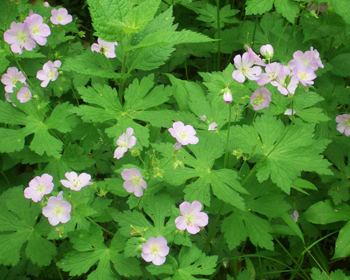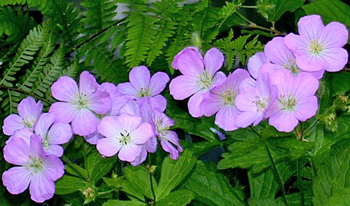Contents:
Common Names | Parts Usually Used | Plant(s) & Culture | Where Found | Medicinal Properties | Biochemical Information
Uses | Formulas or Dosages | Bibliography
Scientific Names

- Geranium maculatum L.
- Geraniaceae
- Geramium family
Common Names
- Alum root
- American kino root
- American tormentil
- Crowfoot
- Dovesfoot
- Geranium
- Storksbill
- Spotted cranesbill
- Spotted geranium
- Tormentil
- Wild cranesbill
- Wild dovesfoot
- Wild geranium
Parts Usually Used
Root
Back to Top
Description of Plant(s) and Culture

Cranesbill is a perennial plant 1-2 feet high with a thick rhizome and long stalked, palmately divided basal leaves; leaves broad, deeply 5-parted, segments toothed. Flowers pink to lavender (rarely white), 5 petaled, bowl shaped, grow in small terminal clusters, on long stalks in the axils of stem leaves; April-June. Fruits are like 5-part beaks, which split into spoon-shaped sections. Distinct “crane’s bill” in the center of the flower enlarges into seedpod. Full sun or partial shade. Zones 3-10. Not heat-tolerant.
The leaves of cranesbill (wild geranium) are often confused with those of Goldenseal, though cranesbill leaves are not wrinkled and have more deeply cut lobes.
Back to Top
Where Found
Woods, thickets, on shady roadsides, and in meadows. Maine to Georgia; Arkansas, Kansas to Manitoba.
Back to Top
Medicinal Properties
Astringent, styptic, antiseptic
Back to Top
Biochemical Information
Root is tannin rich (10-20%), tannic and gallic acid, starch, sugar, pectin, gum.
Back to Top
Uses
Useful as an infusion in cholera, diarrhea, and dysentery. Use tea for mouthwash for mouth sores and bleeding gums, and profuse menstrual bleeding, bleeding wounds, nosebleed, bleeding from extracted teeth. The dry powder sprinkled on a wound or cut will stop bleeding immediately. Used for old chronic ulcers. Strong tea solution rubbed on breasts will stop milk flow, rubbed on nipples will harden them. Internally, for piles inject as an enema 2-3 tbsp. of strong tea several times a day, and after each stool. Excellent for mucus and pus in the bladder and intestines, for leukorrhea or mucous discharges from any part of the body. Useful in diabetes or Bright’s disease. Externally, used as a folk cancer remedy.
Back to Top
Formulas or Dosages
Use dried rhizomes (root).
For mucous discharges, try equal parts golden seal and cranesbill. Use a tsp. of each to a pint of boiling water. Let steep 30 minutes; use this liquid as an injection for piles, as a douche, or take internally, a tbsp. 4-6 times a day. Also, for hemorrhoids, combine finely powdered cranesbill with powdered yarrow. These made into an ointment or bolus by then adding melted coconut butter or vaseline until a doughy consistency is achieved. Roll this mixture into anal suppositories of about the thickness of the middle finger. Insert inch-long pieces into the rectum each evening before retiring.
For general use, steep 1 heaping tsp. in 1 cup of boiling water 30 minutes. Drink 1 or more cupfuls a day, a large mouthful at a time; children less according to age and weight.
Back to Top
Bibliography
![]() Back to Eden
Back to Eden, by Jethro Kloss; Back to Eden Publishing Co., Loma Linda, CA 92354, Original copyright 1939, revised edition 1994
![]() Eastern/Central Medicinal Plants
Eastern/Central Medicinal Plants, by Steven Foster and James A. Duke., Houghton Mifflin Company, 215 Park Avenue South, New York, NY 10000
![]() The Nature Doctor: A Manual of Traditional and Complementary Medicine
The Nature Doctor: A Manual of Traditional and Complementary Medicine, by Dr. H.C.A. Vogel; Keats Publishing, Inc., 27 Pine Street (Box 876) New Canaan, CT. 06840-0876. Copyright Verlag A. Vogel, Teufen (AR) Switzerland 1952, 1991
![]() The Herbalist Almanac
The Herbalist Almanac, by Clarence Meyer, Meyerbooks, publisher, PO Box 427, Glenwood, Illinois 60425, copyright 1988, fifth printing, 1994
Herbal Gardening, compiled by The Robison York State Herb Garden, Cornell Plantations, Matthaei Botanical Gardens of the University of Michigan, University of California Botanical Garden, Berkeley., Pantheon Books, Knopf Publishing Group, New York, 1994, first edition
![]() Planetary Herbology
Planetary Herbology, by Michael Tierra, C.A., N.D., O.M.D., Lotus Press, PO Box 325, Twin Lakes. WI 53181., Copyright 1988, published 1992
![]() The Complete Medicinal Herbal
The Complete Medicinal Herbal, by Penelope Ody, Dorling Kindersley, Inc, 232 Madison Avenue, New York, NY 10016, First American Edition, copyright 1993
![]() Indian Herbalogy of North America
Indian Herbalogy of North America, by Alma R. Hutchens, Shambala Publications, Inc., Horticultural Hall, 300 Massachusetts Avenue, Boston, Massachusetts 02115, 1973
![]() American Folk Medicine
American Folk Medicine, by Clarence Meyer, Meyerbooks, publisher, PO Box 427, Glenwood, Illinois 60425, 1973
![]() Webster’s New World Dictionary
Webster’s New World Dictionary, Third College Edition, Victoria Neufeldt, Editor in Chief, New World Dictionaries: A Division of Simon & Schuster, Inc., 15 Columbus Circle, New York, NY 10023
 How Indians Use Wild Plants for Food, Medicine & Crafts
How Indians Use Wild Plants for Food, Medicine & Crafts, by Frances Densmore, Dover Publications, Inc., 180 Varick Street, New York, NY 10014, first printed by the United States Government Printing Office, Washington, in 1928, this Dover edition 1974
 An Instant Guide to Medicinal Plants
An Instant Guide to Medicinal Plants, by Pamela Forey and Ruth Lindsay, Crescent Books (January 27, 1992).
![]() The Yoga of Herbs: An Ayurvedic Guide to Herbal Medicine
The Yoga of Herbs: An Ayurvedic Guide to Herbal Medicine, by Dr. David Frawley & Dr. Vasant Lad, Lotus Press, Twin Lakes, Wisconsin, Second edition, 1988.
 The Rodale Herb Book: How to Use, Grow, and Buy Nature’s Miracle Plants (An Organic gardening and farming book)
The Rodale Herb Book: How to Use, Grow, and Buy Nature’s Miracle Plants (An Organic gardening and farming book), edited by William H. Hylton, Rodale Press, Inc. Emmaus, PA, 18049., 1974
